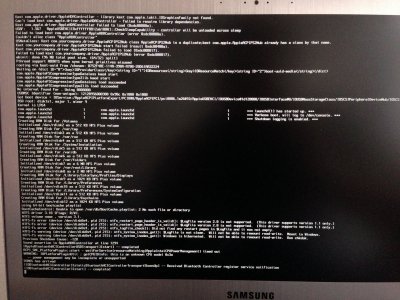Hi ElementX. Thanks for the reply. Yes I have tried voodoohda. None of them work. The only one that actually works is 2.8.2 but here are problems I get. When booting i get a big pop sound from the speaker. My understanding its OSX related with turning speakers off. After a few minutes sound crackles and distorts. I have to go to midi and resample to a different frequency. It fixes it but a few minutes later starts again. The mic is also shaky. Maybe someone has a fix for these things. I see some folks have gotten this alc269vc working but looks like even same chip, acts differently on different laptops. I'm hoping maybe I made a mistake trying to patch. I keep looking and searching..hoping to stumble on something or someone with more insight
I was also getting the loud pop during boot and a kernel panic about 50% of the time. The rest of the time I was getting a horrible feedback form my built-in microphone. All this stopped once I modified the VoodooHDA.kext to set the input gain to 0. I used VodooHDA v0.2.7.3. I am re-posting the steps, in case you want to try that.
Steps to install and fix VoodooHDA:
0. Go to
/System/Library/Extensions of your main Hackintosh hard drive and delete
AppleHDA.kext.
1. Download
Kext Utility v2.5.1 (Mac OS X “Mountain Lion” edition).
2. Run MultiBeast 5.2.1 and check
VoodooHDA 0.2.7.3 found under Drivers & Bootloaders - Drivers -Audio - Universal.
3. Soon after the installation completes, a high pitched sound will start coming out of your speakers. This is a feedback caused by the microphone located immediately to the left of your mouse pad.
4. Put your finger over it to reduce the sound. Then go to
System Preferences and click on
VoodooHDA (at the very bottom under Other). Move the
Input Gain slider all the day down to
0. Now you can lift your finder from the microphone - the feedback is gone and your audio is working. But don't get too excited just yet!
5.
Do not reboot yet - if you do the feedback will be back, since the Input Gain value was not saved. You will need to modify its value in the VoodooHDA.kext itself.
6. Open Finder and go to
/System/Library/Extensions of your main Hackintosh hard drive. Locate
VoodooHDA.kext and copy it to your Desktop. Then delete it from /System/Library/Extensions.
7. Select
VoodooHDA.kext on your desktop, right click on it and choose Show Package Contents. Under Contents you will see a file called
Info.plist. Right click on it and open it with TextEdit. Find this:
<key>iGain</key>
<string>90</string>
and change the
90 to
0. Then save the file and close TextEdit.
8. Now run the
Kext Utility you downloaded in step 1. If you get an error saying that it cannot run since it was downloaded from the Internet, just right click on it and select Open.
9. Grab the
VoodooHDA.kext from your desktop and drop it inside the main window of the Kext Utility. It will ask you for a password twice. Once it finishes, you will see a Quit button on the bottom.
10.
Reboot.

